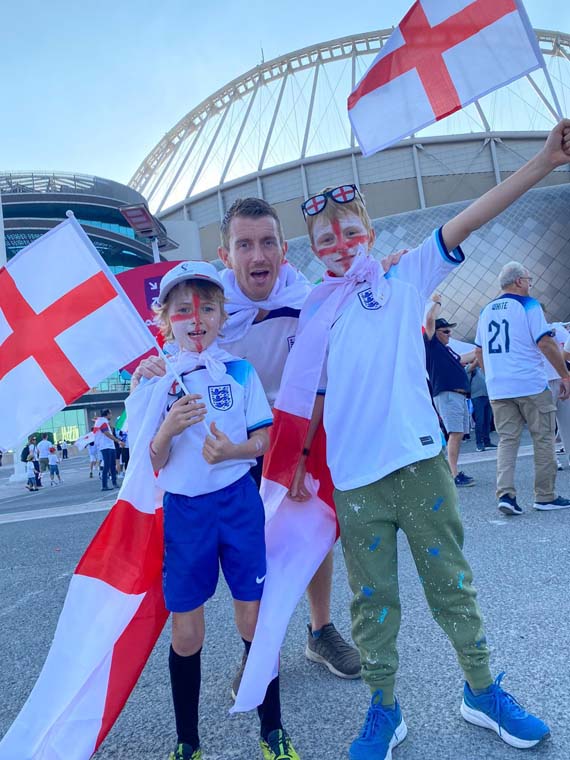It’d been twelve years in the making. The day finally that everyone had been waiting for arrived on 20 November 2022, when FIFA World Cup Qatar 2022 kicked off at the breathtakingly impressive Al Bayt Stadium. The tournament’s opening ceremony was inaugurated with a message of inclusion from the Emir of Qatar, His Highness Sheikh Tamim bin Hamad Al Thani, where he stated: “How beautiful it is for people to put aside what divides them in order to celebrate their diversity and what brings them together at the same time.”
This message exemplified the tournament’s spirit from day one, which started with the ceremony’s seven-act programme introducing Qatar to the world. The performances incorporated Qatari tradition with influences from around the world and featured tributes to the competing teams and previous World Cup hosts. It gave us all a taste of what Qatar is capable of, which was only magnified over the next four weeks. And no one can forget the powerful and moving dialogue between Morgan Freeman and Ghanim Al Muftah, the young Qatari entrepreneur and philanthropist who was born with caudal regression syndrome. The exchange began with a quote from chapter 49, verse 13 of the Quran that champions human diversity and ended with a welcoming invitation to Doha from Al Muftah.
Since then, this message of inclusion towards people of all cultures, colours, ages, and abilities has been echoed throughout the tournament—inside and outside matches. The local schoolchildren from all backgrounds who were invited to the pitch as mascots and flag bearers for each game and the scenes of Qataris helping fans don the ghutrah that were widespread on social media were just a few examples. My family and I also experienced it firsthand.
Family-friendly Game Day
I was fortunate enough to get the chance to attend various matches, fan parks, and fan zones on my own and with my children. Our first family game was the second of the tournament, and it was the England vs Iran match on 21 November 2022. Before heading up to the game, along with two of my children, I was apprehensive about what to expect with so many fans pouring into the country. Still, the excitement was palpable as we headed to the stadium from our compound (which was within walking distance) with Hayya cards at the ready and our tickets activated.

Guides directed us and many others into the stadium from the metro and taxi ranks, and parking spaces were abundant. Iran and England fans mingled, happy and excited, as we all queued together to move into the perimeter of Khalifa International Stadium. This seamless operation took around 15 minutes, including the part where we passed through security scanners.
As the stadium loomed in front of us, we were greeted by a friendly Egyptian FIFA volunteer called Zarah. She handed out wristbands where parents could print their details in case their children got lost. This was very reassuring, as thousands of fans were about to take their seats to watch the game. With an official attendance of 45,334, the stadium was alive with the roar of support, yet it somehow didn’t feel too crowded. The food and drink venues held plentiful stock from official sponsors, and the toilets were clean and easily accessible from our seats. It was the first in-stadium match for us and many others in the crowd and an unforgettable experience.
A World Cup for All
At that match, I learnt about Aiden, a 10-year-old British resident who came with his family. Aiden has cerebral palsy and is a wheelchair user who was thrilled to be able to watch England play at Khalifa International Stadium. The easily accessible seating for wheelchair users at the stadium made it possible for Aiden to watch the Three Lions with his family.
Just before the game started, two FIFA representatives approached Aiden and his dad George and offered them the chance of a lifetime to head onto the pitch in time for the national anthem. Singing the national anthem with their footballing heroes is something I am sure neither of them will ever forget! What followed, of course, was a spectacular match where a total of eight goals were scored—an incredible night overall.
Accessibility was always at the forefront of this World Cup. FIFA president Gianni Infantino said that FIFA World Cup Qatar 2022 would be “the most accessible World Cup ever”, with facilities across all stadiums catering to those with various disabilities. These included wheelchair access ramps, priority lanes, and wheelchair-accessible public transport connections. Every game included commentaries for blind fans in English and Arabic. And for the first time at the tournament, sensory rooms were included in three iconic stadiums—Al Bayt, Lusail, and Education City stadiums—and six other rooms near the buzzing fan zones across the country. These oases of calm offer respite to people with autism or other sensory issues, allowing them to retreat when the big-match atmosphere becomes overwhelming.
The effect of these inclusion efforts was evident in the crowds of all eight stadiums. You could see whole families soaking up the atmosphere, filled wheelchair access seats, and many wearing ear defenders while cheering for their teams. Designated stroller parking stations were also available around the stands, solidifying that this was an event for all ages. You could even see it in the fans’ spirits, with all the beaming faces displayed across stadiums screens and the clear camaraderie between people of all backgrounds in fan zones, metro lines, and malls. It was even visible at the water shows, concerts, and fireworks displays held throughout the tournament.
Qatar, the first Arab country to host a World Cup, promised an event that was accessible to all. Clearly, it has gone above and beyond to deliver that, and I believe it did so successfully. This tournament was a source of pride for Qataris, residents, and visitors, and I wholeheartedly consider it an experience of a lifetime for all of us.